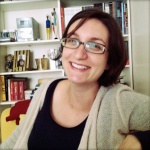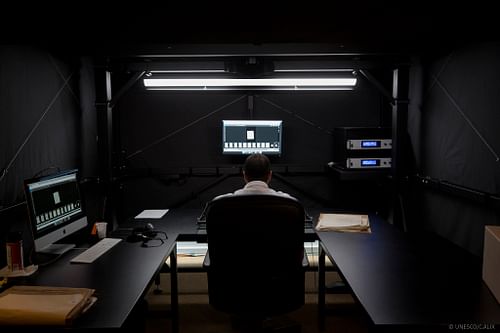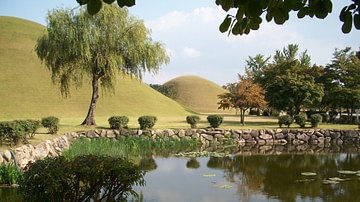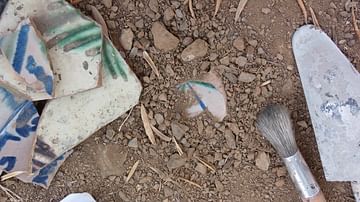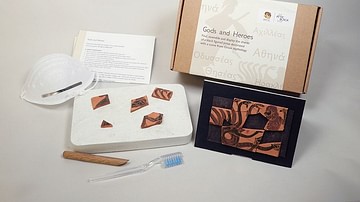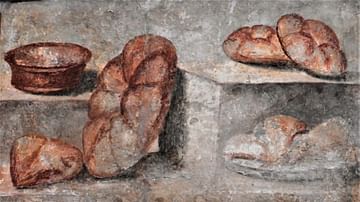Ancient History Encyclopedia has partnered with the UNESCO Archives, which we are very excited about. Our mission aligns very much with UNESCO, wanting to bring about peace and international understanding to the world through cultural heritage and education. We sat down with Mr. Adam Cowling, the Digitization Project Manager to talk about their project and where it is headed. What they do in their archives is absolutely fascinating.
AHE: Tell us about your project. What is your mission? What are its objectives?
AC: This is a really exciting project because in UNESCO's archives and historical audiovisual collections you can find evidence of over 70 years of ideas and actions for peace and international understanding within the Organization's wide-ranging fields of competence. This wealth of knowledge and experience is at risk, particularly the audiovisual collections that date back to the late 1940s (including films, videos, audio recordings, and photos).
To preserve UNESCO's shared documentary heritage, we had to act fast before it was too late. So, UNESCO Archives launched a digitization initiative, the first phase of which runs until October 2019. In February this year, we installed an on-site digitization laboratory at UNESCO Headquarters in Paris. So far, we have digitized over 500,000 pages, 5,000 photos, and 75 hours of film and video… and we are just getting started.
This project aims to help preserve but, of course, also to make key parts of our collective memory available to a large public. The paper archives we are digitizing are already open to the public at the Archives at UNESCO Headquarters, but most of the audiovisual collections have been inaccessible to the general public until now. These archives and collections are being made available over the course of the project at digital.archives.unesco.org for the world to explore and discover.
AHE: Can you tell us a bit more about how the project got started?
AC: Following an internal transfer of the historical audiovisual collections from the Division for Public Information to the UNESCO Archives in 2015, we issued a call for funds to UNESCO's Members States. Thanks to the generous support of the Government of Japan, we were able to launch this ambitious first phase in 2017.
AHE: What were the biggest challenges you had to face?
AC: This undertaking is not really just a single project; it is more like five or six. Each format being digitized (e.g. archive files, bound volumes, photographs, audio recordings, 16mm films, and Umatic videos) requires different treatment and different expertise. We were also excited to launch an experimental crowdsourcing subproject, but such a new approach to metadata generation is virgin territory for us as a project team, to be honest.
Also, our depth of knowledge of each collection within the scope of the project varied significantly. Our knowledge of the textual collections was already strong, as this is material that we work with and provide access to on a daily basis, but as already mentioned, the audiovisual collections were almost completely new (and unknown) to us. We had a relatively short period of time to familiarize ourselves with these collections and to become content experts. Due to the age of the material, few people were left around that could give us insight into what we would encounter, how it was organized and inventoried, and the current state of conservation.
Moreover, of course, one of the biggest challenges was to find the financial support required to embark on such a large-scale project in the first place. The UNESCO Archives had never undertaken digitization of textual and audiovisual records on this scale before, so it took some time and convincing to find a partner with the confidence in us to be able to do it successfully.

AHE: I understand this is the first step of your project. Where do you go from here?
AC: We think that UNESCO's institutional heritage is a shared heritage, and we hope that people will be interested in joining us on this journey of discovery. What we are digitizing in the context of this two-year project is a key part of UNESCO's institutional heritage, but it is just a small part.
We still have many treasures to unravel, including over 10 km of historical archives, 170,000 amazing photos, 2,000 extremely interesting films, hours and hours of audio, and the many stories to be revealed by exploring these collections. We are looking for more partners and we hope others will want to join us.
AHE: We are very excited about our partnership! How can partners like Ancient History Encyclopedia help you achieve your goals?
AC: We are very excited as well! Creating partnerships to achieve shared goals are the way to get things done, for sure. We are looking forward to working with AHE to develop immersive educational modules that connect high-quality peer-reviewed articles to digitized media to provide participants with new ways to use, explore, and learn from the archives.
We welcome support and partnership proposals to:
- Use our digital content for archival research
- Present data found in archives with creativity and impact
- Tell stories from archives in new and innovative ways
- Fund the digitization of more archives
- Reach larger and diverse audiences, spread the word, and encourage people to explore and use the archives, and transmit the idea that the UNESCO archives are a shared heritage.
To become a partner, contact UNESCO Archives.
This fall, we will also be asking the public to support us on the Heritage Helpers crowdsourcing website to help us create rich data for the 5,000 amazing digitized photographs.
AHE: Any final words from the archivist in you?
AC: The Mexican poet and second Director-General of UNESCO from 1948 to 1952, Jaime Torres-Bodet, once declared that archives, rather than “vast cemeteries”, are places where one may find “the experiences, adventures, risks, and dramas” of society. He saw archives as crucial to the “continuity of the human conscience” and the possibility of good government. Archives are, he said, the “instructive traces of life”.
Come and help us tell the story of the ideas and actions, programmes and projects, and the efforts attempted and/or achieved to fulfill UNESCO's noble mission!
